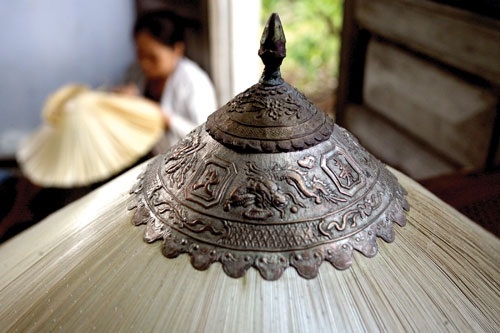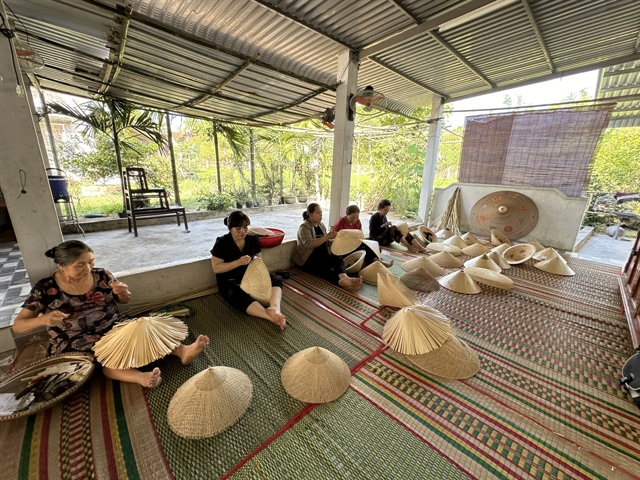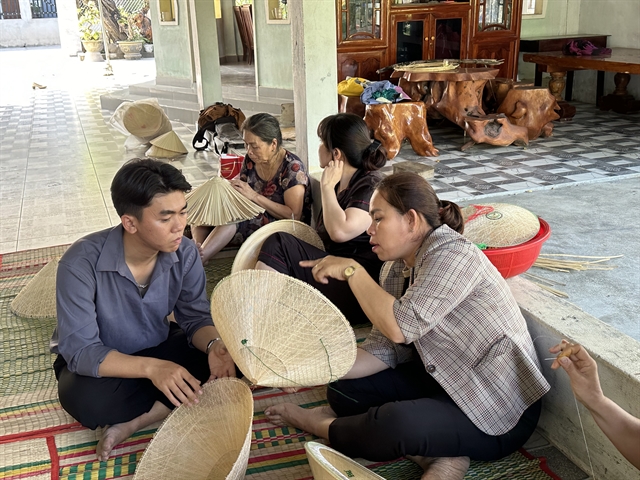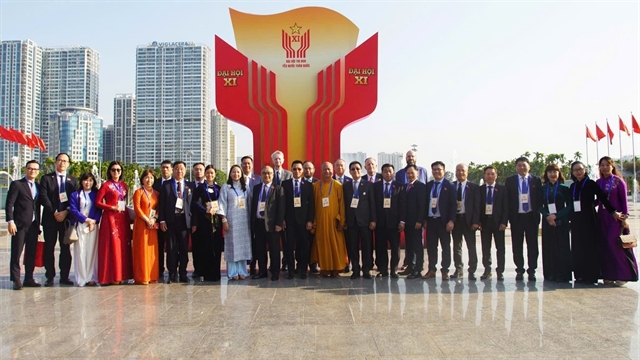 Sunday/Weekend
Sunday/Weekend

By Lê Hương
The south central province of Bình Định not only boasts beautiful natural landscapes with long beaches with turquoise water and soft yellow sand, but is also home to multiple handicraft villages.
Phú Gia Village in Phù Cát District of Quy Nhơn City has been famed for the craft of making conical palm leaf hats for the past 300 years.
The hat here is called “horse hat” as it was worn in the past by the elite when riding their horses. A few families are still keeping the traditional craft alive, which proves a magnet to tourists.
Made with palm leaves, the hats were worn by soldiers in the late 18th century.
A metal piece covering the top of the hat makes it last longer, but more significantly gives it an authoritative look. In the past, mandarins or wealthy people wore hats with silver tops, while the soldiers had simple copper ones.
 |
| ELEGANT DETAILS: A traditional conical palm leaf hat with a copper top made by artisans in the village. VNS Photos Lê Hương |
Generations later, the locals are still making the palm leaf hats for both daily use and souvenirs.
Each hat is made carefully with a bamboo frame before being overlaid with one or two layers of palm leaves.
Lê Văn Lan and Nguyễn Thị Tâm are among the elderly artisans in the village, and they still keep a conical hat made by their ancestors 200 years ago.
The ancient hat had a metal top carved with traditional decorative patterns depicting four holy creatures: the dragon, kylin, tortoise, and phoenix.
“Making hats is not hard work, and it can be done during our time off from the field,” artisan Tâm tells Việt Nam News. “Farmers here are still using this kind of hat in daily life. For example, a bride often wears a hat on her wedding day. People will appreciate its traditional beauty.”
 |
| ANCIENT ART: There are not many people making hats in the village anymore. |
Tâm says their conical hats have been exported to the US, Australia and other countries. However, she says, around 100 households are making hats now, a third of the number just dozens of years ago.
Nguyễn Thị Vân, a middle-aged hat-maker, says she learned the craft from her parents as a teenager.
“My family members had run the business but due to the low income, we have changed to other careers,” she says.
Vân says making conical hats is easy, but everything must be done by hand.
She says that though she quit doing the job full-time, sometimes she still does it alongside tailoring to earn extra money.
The village hosts visitors who are eager to learn the ancient craft and more about the local culture every day.
Nguyễn Thành Danh, a tour guide, says he often takes tourists to Phú Gia Horse Hat Handicraft Village.
 |
| QUICK LESSON: Tour guide Nguyễn Thành Danh (left) learns about the ancient craft. |
“There are more visitors during peak season, especially the ones who want to try making conical hats,” Danh says.
“They include students, middle-aged visitors, and foreigners. Visitors often have chances to try making conical hats. There are even ready-to-wear conical hats for students to draw on. Teachers give marks for their creations.”
Danh says that the 300-year tradition of the craft makes it very valuable.
“I think this tour is vital and meaningful, so tourism companies should include it in their itineraries,” he says.
Locals here are determined to keep the traditional craft alive, though they can hardly earn much money from it.
Tâm says wholesale buyers in the town pay them a very low amount, only VNĐ40,000-50,000 (US$1.60-$2) per hat.
 |
| HATS OFF: Students take a field trip and learn the craft at the house of artisans Lê Văn Lan and Nguyễn Thị Tâm. VNS Photo Nguyễn Thành Danh |
“Hat makers cannot afford their daily expenses,” she says. “Most have quit this job. Now there are only 100 households doing it. I hope authorities will help my husband and I maintain the craft.”
Vân says she hopes local authorities will support her aunt so that she and her husband could train young people to learn the traditional craft to keep it going. VNS




